
Kiowa Shale
Field Trip
June, 2011
Copyright © 2011 by
Mike Everhart
Page created 11/01/2011
Last updated 11/02/2011
LEFT: A view of the exposure where the plesiosaur remains were collected in August, 2011.
 |
Kiowa Shale Field Trip June, 2011
Copyright © 2011 by Mike Everhart
Page created 11/01/2011 Last updated 11/02/2011
LEFT: A view of the exposure where the plesiosaur remains were collected in August, 2011. |
The Kiowa Shale (Lower Cretaceous;
Albian) represents a variety of near-shore marine lithologies, including gray
shales, mudstones and sandstones deposited during the northward advance of the
Plesiosaur bones, although usually isolated, are fairly common in the Kiowa Shale of Clark and Kiowa counties in southern Kansas, and less so in McPherson County in central Kansas. I have been collecting fossils, mostly shark teeth, from the Kiowa Shale for almost 10 years now, I haven't had much luck in locating plesiosaur remains. My fortunes began to change in June, 2008 when I discovered a badly weathered plesiosaur propodial (below) in Clark County. It wasn't much to look at, but it was definitely plesiosaur. Then in August 2008, I collected the left ischium of a small plesiosaur in Kiowa County, near Belvidere.
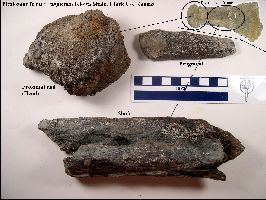 |
LEFT: A fragmented and badly weathered podial of a large
plesiosaur from Clark County. (FHSM VP-17300) RIGHT: Close up of the specimen at left, showing the bone texture. |
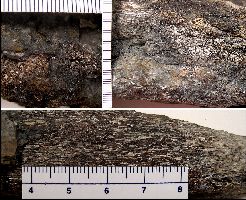 |
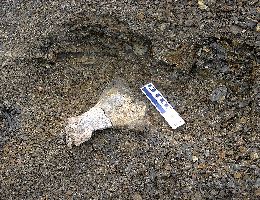 |
LEFT: The left ischium of a small plesiosaur (FHSM VP-17302)
discovered in the basal
Kiowa Shale (Albian) of Kiowa County, Kansas, August, 2008. RIGHT: Dorsal and ventral views of the ischium after preparation and putting it back together. The ischium is about 20 cm in length and would scale up to a plesiosaur that was about 3.3 m long, assuming it was something like Plesiosaurus. Dorsal and ventral views of the same bone after preliminary preparation. |
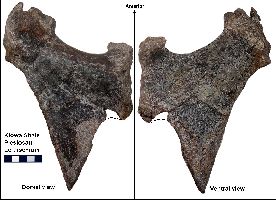 |
Fast forward three years to June 2011 when Ken Brunson and I visited a new site in the Kiowa Shale near Belvidere in Kiowa County.
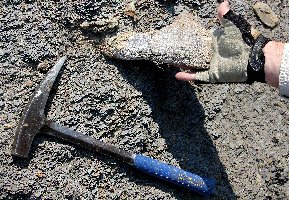 |
We were walking through a large exposure and I decided to
climb up a gully. About half way up, I found the distal end of a
plesiosaur propodial, broken off at mid-shaft, lying on the surface. The adrenalin started
pumping as I looked further up the gully and spotted where the rest of the
bone was still protruding from the shale. I picked up the first piece and carried
uphill to where it had fallen off ... perfect fit...
LEFT: Ken Brunson took this photo of me holding the two pieces together. RIGHT: Obviously very happy... we had just started and it was already a good day! |
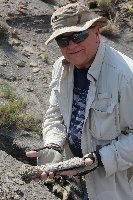 |
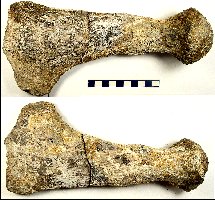 |
LEFT: The plesiosaur propodial (FHSM VP-17708) in dorsal
and ventral views after initial preparation and gluing the two pieces back
together. Judging from the straightness of the shaft, is is probably
the right femur of a medium sized plesiosaur..
RIGHT: More views of the same propodial. |
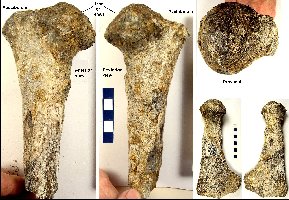 |
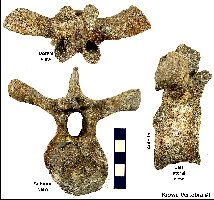 |
We were both pretty excited about the discovery. We
walked around the exposure, with Ken a few steps in front of me. Suddenly
he said, "What's this?"... pointing to a plesiosaur vertebra
that was sitting on top of the shale.
LEFT: Ken had discovered the dorsal vertebra (FHSM VP-17711) of a second plesiosaur....which we photographed and collected. RIGHT: Then, not to be outdone, we walked a few steps and I saw another vertebra (FHSM VP-17710) lying on the shale. This one was a sacral... one of three special vertebrae in the lower back of a plesiosaur where the ilia of the pelvic girdle attach. This one also included the dorsal process which had broken off and was lying several inches away. |
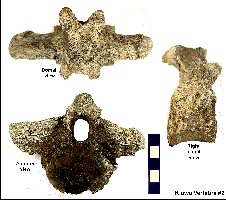 |
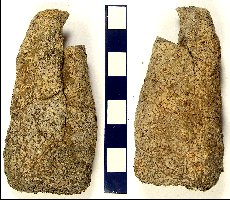 |
LEFT: After I found the second vertebra, I walked over
the exposure again, looking a little more carefully this time. However,
all I found was a really weathered scrap of bone, probably plesiosaur, but
not identifiable beyond that.
RIGHT: A good days collecting... specimen numbers assigned... All four specimens (including the scrap) were found at slightly different levels in the same exposure, more than likely indicating that they came from four different individuals. We spent another couple of hours walking around, but the Kiowa had given up all she was going to give that day. |
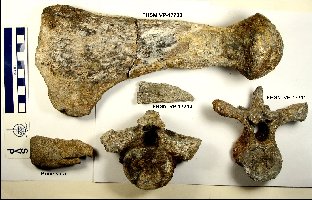 |
Other specimens from the Kiowa Shale (Early Cretaceous - Upper Albian)
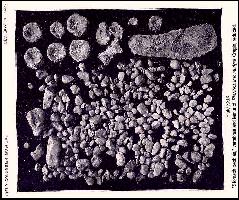 |
LEFT: An old photograph of the remains of a specimen of "Plesiosaurus
mudgei" Cragin (KUVP 1305 - now considered to be a nomen dubium) from the Kiowa
Shale of Clark County, including over 200 gastroliths. Collected by C. N. Gould in 1893,
the specimen cannot be relocated. Similar
stones are found in the lower Kiowa Shale and are interpreted as "probable"
gastroliths: See also this field photo RIGHT: A more recently collected (1962 by M.V. Walker) set of plesiosaur remains (FHSM VP-2170) from the Kiowa Shale of Clark County. One of the lower limb bones of this specimen appears to preserve a large bite mark (Pliosaur or crocodile), Similar remains have been collected from the Kiowa Shale in Kiowa and McPherson counties. |
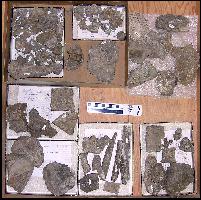 |
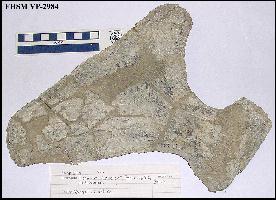 |
LEFT: A portion of the pelvis (ischium) of a plesiosaur (FHSM VP-2984)
from the Kiowa Shale of Clark County. Right: A propodial of a plesiosaur (FHSM VP-2983) from the Kiowa Shale of Clark County. |
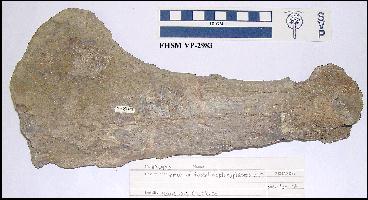 |
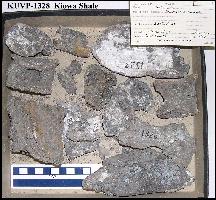 |
LEFT: A box of plesiosaur "scraps" (KUVP 1328), including
several vertebrae collected from the Kiowa Shale of Clark County by C. N. Gould in 1894. RIGHT: The posterior part of a plesiosaur jaw (FHSM VP-2985) collected from the Kiowa Shale of Clark County. Given the large size, it is most likely from a pliosaur like Brachauchenius. |
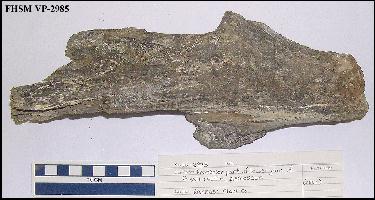 |
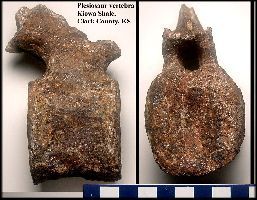 |
LEFT: Four views of a recently collected (2006) plesiosaur
vertebra (FHSM VP-16386) from the Kiowa Shale of Clark County. RIGHT: Two views of a single cervical vertebra (KUVP 16215) from the Kiowa Shale of Clark County. |
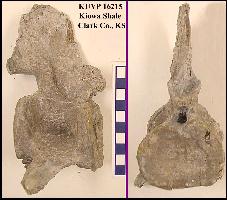 |
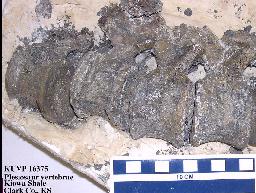 |
LEFT: Part of a series of more than 15 articulated cervical vertebrae (KUVP 16375) from small plesiosaur collected in Clark County by Bonner and Williams. RIGHT: The articular portion from the back of the jaw of a large plesiosaur (KUVP 85289) from the Kiowa Shale, Clark Co., Kansas.
|
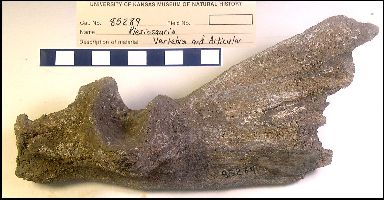 |
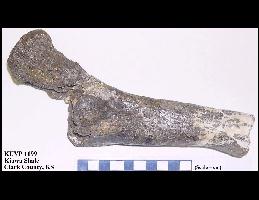 |
LEFT: The proximal end of an unusual bone (KUVP 1199) collected
by S. W. Williston from the Kiowa Shale (Clark County) in 1893. Originally thought to be
the femur of a crocodile, Williston (1903) later described it as a new species of giant
pterosaur ("Apatomerus mirus"). It is most likely the upper end of a
plesiosaur propodial. RIGHT: The upper portion of a similar plesiosaur propodial (KUVP 16216) collected from the Kiowa Shale of Clark County. |
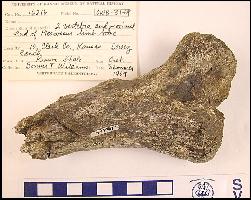 |
KIOWA SHALE REFERENCES:
Beamon, J.C. 1999. Depositional environment and fossil biota of a thin
clastic unit of the Kiowa Formation, Lower Cretaceous (Albian),
Cragin, F.W. 1894. Vertebrata from the Neocomian of Kansas. Colorado College Studies v pp. 69-73, pls. i, ii.
Everhart, M.J. 2005. Probable plesiosaur gastroliths from the basal Kiowa Shale (Early Cretaceous) of Kiowa County, Kansas. Kansas Academy of Science, Transactions 108 (3/4): 109-115.
Lane, H.H. 1946. A survey of the fossil vertebrates of Kansas, Part III, The Reptiles. Kansas Academy Science, Transactions 49(3):289-332, 7 figs.
Schultze, H.-P., Hunt, L., Chorn, J. and Neuner, A.M. 1985. Type and figured specimens of fossil vertebrates in the collection of the University of Kansas Museum of Natural History, Part II. Fossil Amphibians and Reptiles. Miscellaneous Publications of the University of Kansas Museum of Natural History 77:66 pp.
Williston, S.W. 1894. On various vertebrate remains from the lowermost Cretaceous of Kansas. Kansas University Quarterly 3(1):1-4, pl. I.
Williston, S.W. 1897. A new plesiosaur from the Kansas Comanche Cretaceous. Kansas University Quarterly 4:57.